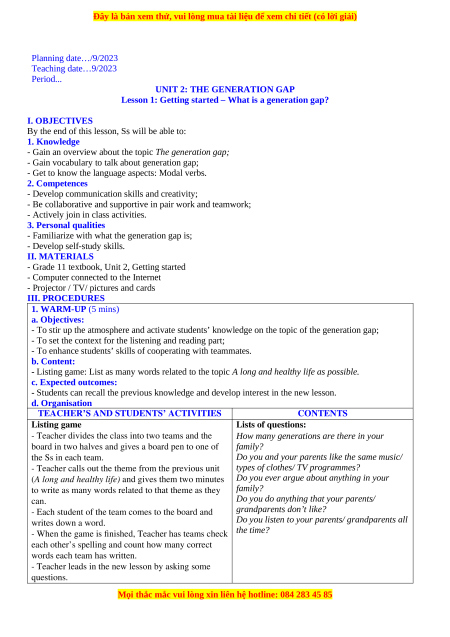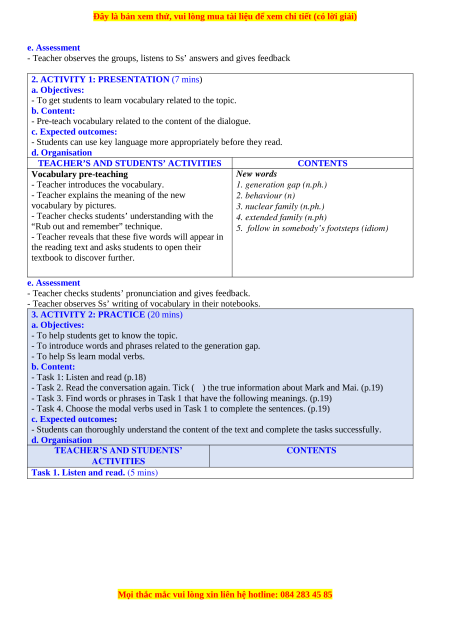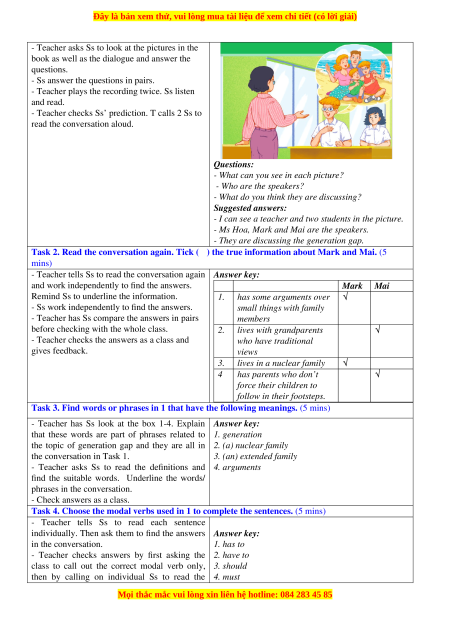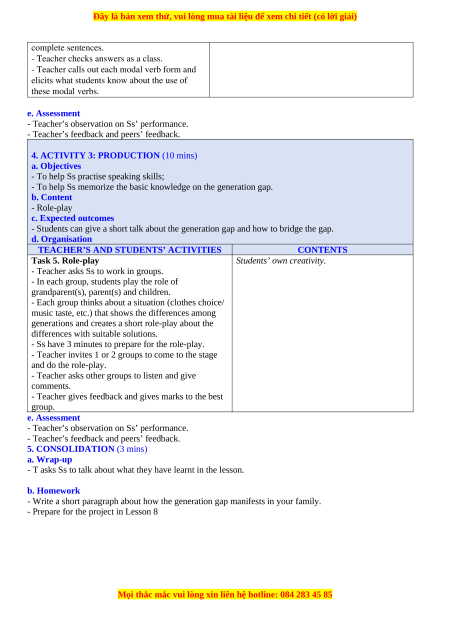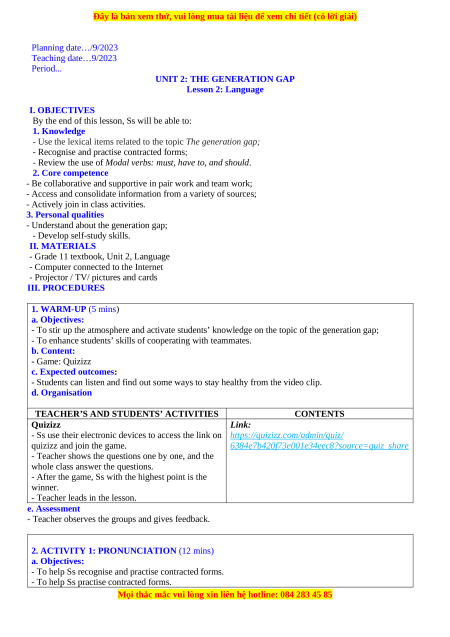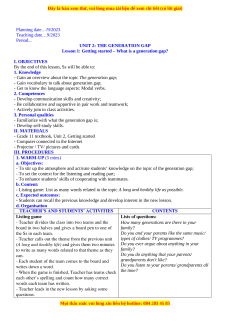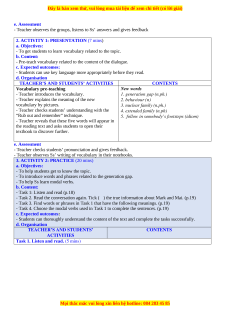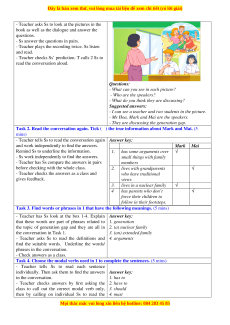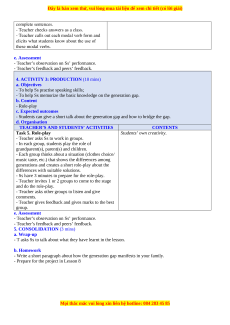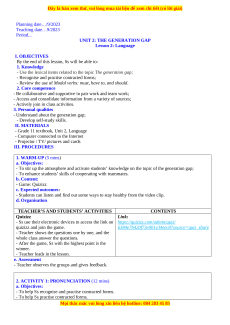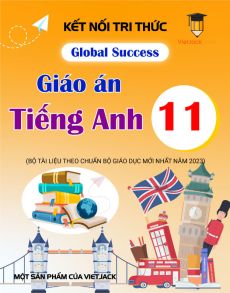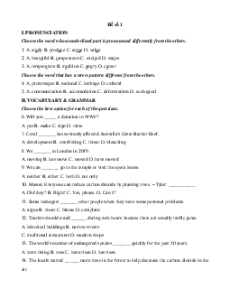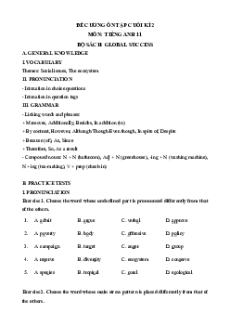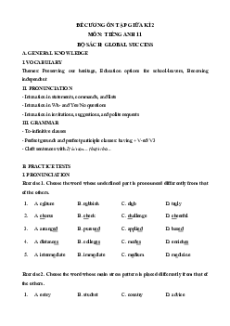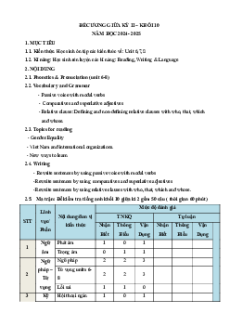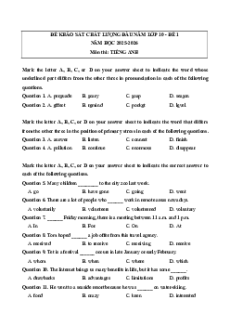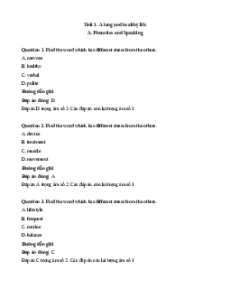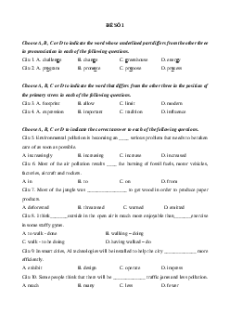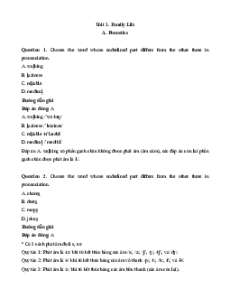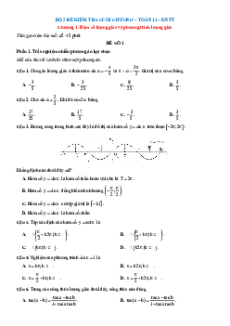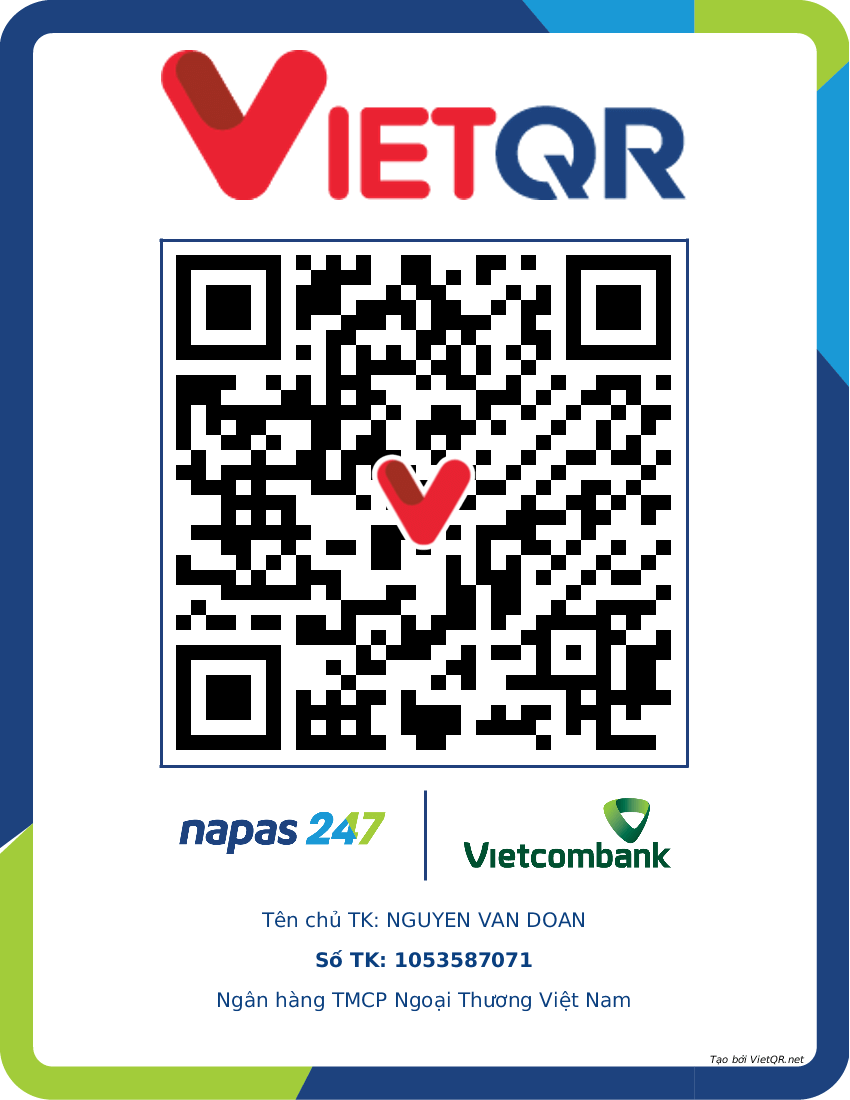Planning date…/9/2023 Teaching date…9/2023 Period...
UNIT 2: THE GENERATION GAP
Lesson 1: Getting started – What is a generation gap? I. OBJECTIVES
By the end of this lesson, Ss will be able to: 1. Knowledge
- Gain an overview about the topic The generation gap;
- Gain vocabulary to talk about generation gap;
- Get to know the language aspects: Modal verbs. 2. Competences
- Develop communication skills and creativity;
- Be collaborative and supportive in pair work and teamwork;
- Actively join in class activities. 3. Personal qualities
- Familiarize with what the generation gap is; - Develop self-study skills. II. MATERIALS
- Grade 11 textbook, Unit 2, Getting started
- Computer connected to the Internet
- Projector / TV/ pictures and cards III. PROCEDURES 1. WARM-UP (5 mins) a. Objectives:
- To stir up the atmosphere and activate students’ knowledge on the topic of the generation gap;
- To set the context for the listening and reading part;
- To enhance students’ skills of cooperating with teammates. b. Content:
- Listing game: List as many words related to the topic A long and healthy life as possible. c. Expected outcomes:
- Students can recall the previous knowledge and develop interest in the new lesson. d. Organisation
TEACHER’S AND STUDENTS’ ACTIVITIES CONTENTS Listing game Lists of questions:
- Teacher divides the class into two teams and the
How many generations are there in your
board in two halves and gives a board pen to one of family? the Ss in each team.
Do you and your parents like the same music/
- Teacher calls out the theme from the previous unit
types of clothes/ TV programmes?
(A long and healthy life) and gives them two minutes Do you ever argue about anything in your
to write as many words related to that theme as they family? can.
Do you do anything that your parents/
- Each student of the team comes to the board and
grandparents don’t like? writes down a word.
Do you listen to your parents/ grandparents all
- When the game is finished, Teacher has teams check the time?
each other’s spelling and count how many correct words each team has written.
- Teacher leads in the new lesson by asking some questions.
e. Assessment
- Teacher observes the groups, listens to Ss’ answers and gives feedback
2. ACTIVITY 1: PRESENTATION (7 mins) a. Objectives:
- To get students to learn vocabulary related to the topic. b. Content:
- Pre-teach vocabulary related to the content of the dialogue. c. Expected outcomes:
- Students can use key language more appropriately before they read. d. Organisation
TEACHER’S AND STUDENTS’ ACTIVITIES CONTENTS Vocabulary pre-teaching New words
- Teacher introduces the vocabulary.
1. generation gap (n.ph.)
- Teacher explains the meaning of the new 2. behaviour (n) vocabulary by pictures.
3. nuclear family (n.ph.)
- Teacher checks students’ understanding with the
4. extended family (n.ph)
“Rub out and remember” technique.
5. follow in somebody’s footsteps (idiom)
- Teacher reveals that these five words will appear in
the reading text and asks students to open their textbook to discover further. e. Assessment
- Teacher checks students’ pronunciation and gives feedback.
- Teacher observes Ss’ writing of vocabulary in their notebooks.
3. ACTIVITY 2: PRACTICE (20 mins) a. Objectives:
- To help students get to know the topic.
- To introduce words and phrases related to the generation gap.
- To help Ss learn modal verbs. b. Content:
- Task 1: Listen and read (p.18)
- Task 2. Read the conversation again. Tick ( ) the true information about Mark and Mai. (p.19)
- Task 3. Find words or phrases in Task 1 that have the following meanings. (p.19)
- Task 4. Choose the modal verbs used in Task 1 to complete the sentences. (p.19) c. Expected outcomes:
- Students can thoroughly understand the content of the text and complete the tasks successfully. d. Organisation
TEACHER’S AND STUDENTS’ CONTENTS ACTIVITIES
Task 1. Listen and read. (5 mins)
- Teacher asks Ss to look at the pictures in the
book as well as the dialogue and answer the questions.
- Ss answer the questions in pairs.
- Teacher plays the recording twice. Ss listen and read.
- Teacher checks Ss’ prediction. T calls 2 Ss to read the conversation aloud. Questions:
- What can you see in each picture?
- Who are the speakers?
- What do you think they are discussing?
Suggested answers:
- I can see a teacher and two students in the picture.
- Ms Hoa, Mark and Mai are the speakers.
- They are discussing the generation gap.
Task 2. Read the conversation again. Tick ( ) the true information about Mark and Mai. (5 mins)
- Teacher tells Ss to read the conversation again Answer key:
and work independently to find the answers. Mark Mai
Remind Ss to underline the information. 1.
has some arguments over √
- Ss work independently to find the answers.
small things with family
- Teacher has Ss compare the answers in pairs members
before checking with the whole class. 2.
lives with grandparents √
- Teacher checks the answers as a class and who have traditional gives feedback. views 3.
lives in a nuclear family √ 4
has parents who don’t √
force their children to
follow in their footsteps.
Task 3. Find words or phrases in 1 that have the following meanings. (5 mins)
- Teacher has Ss look at the box 1-4. Explain Answer key:
that these words are part of phrases related to 1. generation
the topic of generation gap and they are all in 2. (a) nuclear family the conversation in Task 1. 3. (an) extended family
- Teacher asks Ss to read the definitions and 4. arguments
find the suitable words. Underline the words/ phrases in the conversation. - Check answers as a class.
Task 4. Choose the modal verbs used in 1 to complete the sentences. (5 mins)
- Teacher tells Ss to read each sentence
individually. Then ask them to find the answers Answer key: in the conversation. 1. has to
- Teacher checks answers by first asking the 2. have to
class to call out the correct modal verb only, 3. should
then by calling on individual Ss to read the 4. must
complete sentences.
- Teacher checks answers as a class.
- Teacher calls out each modal verb form and
elicits what students know about the use of these modal verbs. e. Assessment
- Teacher’s observation on Ss’ performance.
- Teacher’s feedback and peers’ feedback.
4. ACTIVITY 3: PRODUCTION (10 mins) a. Objectives
- To help Ss practise speaking skills;
- To help Ss memorize the basic knowledge on the generation gap. b. Content - Role-play c. Expected outcomes
- Students can give a short talk about the generation gap and how to bridge the gap. d. Organisation
TEACHER’S AND STUDENTS’ ACTIVITIES CONTENTS Task 5. Role-play
Students’ own creativity.
- Teacher asks Ss to work in groups.
- In each group, students play the role of
grandparent(s), parent(s) and children.
- Each group thinks about a situation (clothes choice/
music taste, etc.) that shows the differences among
generations and creates a short role-play about the
differences with suitable solutions.
- Ss have 3 minutes to prepare for the role-play.
- Teacher invites 1 or 2 groups to come to the stage and do the role-play.
- Teacher asks other groups to listen and give comments.
- Teacher gives feedback and gives marks to the best group. e. Assessment
- Teacher’s observation on Ss’ performance.
- Teacher’s feedback and peers’ feedback.
5. CONSOLIDATION (3 mins) a. Wrap-up
- T asks Ss to talk about what they have learnt in the lesson. b. Homework
- Write a short paragraph about how the generation gap manifests in your family.
- Prepare for the project in Lesson 8
Giáo án Unit 2: The generation gap Tiếng Anh 11 Global success
1.7 K
870 lượt tải
MUA NGAY ĐỂ XEM TOÀN BỘ TÀI LIỆU
CÁCH MUA:
- B1: Gửi phí vào TK:
1133836868- CT TNHH DAU TU VA DV GD VIETJACK - Ngân hàng MB (QR) - B2: Nhắn tin tới Zalo VietJack Official ( nhấn vào đây ) để xác nhận thanh toán và tải tài liệu - giáo án
Liên hệ ngay Hotline hỗ trợ: 084 283 45 85
Bộ giáo án Tiếng Anh 11 Global success được cập nhật liên tục trong gói này từ nay đến hết tháng 3/2024.
Để tải tài liệu gốc về máy bạn click vào nút Tải Xuống ở trên!
Thuộc bộ (mua theo bộ để tiết kiệm hơn):
- Bộ giáo án Tiếng Anh 11 Global success năm 2023 kèm mô tả ma trận đề kiểm tra và kế hoạch giảng dạy mới, chuẩn nhất được thiết kế theo phong cách hiện đại, đẹp mắt, trình bày chi tiết cho từng bài học và bám sát chương trình Sách giáo khoa Tiếng Anh 11 Kết nối tri thức.
- Mua trọn bộ sẽ tiết kiệm hơn tải lẻ 50%.
Đánh giá
4.6 / 5(1739 )5
4
3
2
1
Trọng Bình
Tài liệu hay
Giúp ích cho tôi rất nhiều
Duy Trần
Tài liệu chuẩn
Rất thích tài liệu bên VJ soạn (bám sát chương trình dạy)
TÀI LIỆU BỘ BÁN CHẠY MÔN Tiếng Anh
Xem thêmTÀI LIỆU BỘ BÁN CHẠY Lớp 11
Xem thêmTài liệu bộ mới nhất

Đây là bản xem thử, vui lòng mua tài liệu để xem chi tiết (có lời giải)
Planning date…/9/2023
Teaching date…9/2023
Period...
UNIT 2: THE GENERATION GAP
Lesson 1: Getting started – What is a generation gap?
I. OBJECTIVES
By the end of this lesson, Ss will be able to:
1. Knowledge
- Gain an overview about the topic The generation gap;
- Gain vocabulary to talk about generation gap;
- Get to know the language aspects: Modal verbs.
2. Competences
- Develop communication skills and creativity;
- Be collaborative and supportive in pair work and teamwork;
- Actively join in class activities.
3. Personal qualities
- Familiarize with what the generation gap is;
- Develop self-study skills.
II. MATERIALS
- Grade 11 textbook, Unit 2, Getting started
- Computer connected to the Internet
- Projector / TV/ pictures and cards
III. PROCEDURES
1. WARM-UP (5 mins)
a. Objectives:
- To stir up the atmosphere and activate students’ knowledge on the topic of the generation gap;
- To set the context for the listening and reading part;
- To enhance students’ skills of cooperating with teammates.
b. Content:
- Listing game: List as many words related to the topic A long and healthy life as possible.
c. Expected outcomes:
- Students can recall the previous knowledge and develop interest in the new lesson.
d. Organisation
TEACHER’S AND STUDENTS’ ACTIVITIES CONTENTS
Listing game
- Teacher divides the class into two teams and the
board in two halves and gives a board pen to one of
the Ss in each team.
- Teacher calls out the theme from the previous unit
(A long and healthy life) and gives them two minutes
to write as many words related to that theme as they
can.
- Each student of the team comes to the board and
writes down a word.
- When the game is finished, Teacher has teams check
each other’s spelling and count how many correct
words each team has written.
- Teacher leads in the new lesson by asking some
questions.
Lists of questions:
How many generations are there in your
family?
Do you and your parents like the same music/
types of clothes/ TV programmes?
Do you ever argue about anything in your
family?
Do you do anything that your parents/
grandparents don’t like?
Do you listen to your parents/ grandparents all
the time?
Mọi thắc mắc vui lòng xin liên hệ hotline: 084 283 45 85

Đây là bản xem thử, vui lòng mua tài liệu để xem chi tiết (có lời giải)
e. Assessment
- Teacher observes the groups, listens to Ss’ answers and gives feedback
2. ACTIVITY 1: PRESENTATION (7 mins)
a. Objectives:
- To get students to learn vocabulary related to the topic.
b. Content:
- Pre-teach vocabulary related to the content of the dialogue.
c. Expected outcomes:
- Students can use key language more appropriately before they read.
d. Organisation
TEACHER’S AND STUDENTS’ ACTIVITIES CONTENTS
Vocabulary pre-teaching
- Teacher introduces the vocabulary.
- Teacher explains the meaning of the new
vocabulary by pictures.
- Teacher checks students’ understanding with the
“Rub out and remember” technique.
- Teacher reveals that these five words will appear in
the reading text and asks students to open their
textbook to discover further.
New words
1. generation gap (n.ph.)
2. behaviour (n)
3. nuclear family (n.ph.)
4. extended family (n.ph)
5. follow in somebody’s footsteps (idiom)
e. Assessment
- Teacher checks students’ pronunciation and gives feedback.
- Teacher observes Ss’ writing of vocabulary in their notebooks.
3. ACTIVITY 2: PRACTICE (20 mins)
a. Objectives:
- To help students get to know the topic.
- To introduce words and phrases related to the generation gap.
- To help Ss learn modal verbs.
b. Content:
- Task 1: Listen and read (p.18)
- Task 2. Read the conversation again. Tick ( ) the true information about Mark and Mai. (p.19)
- Task 3. Find words or phrases in Task 1 that have the following meanings. (p.19)
- Task 4. Choose the modal verbs used in Task 1 to complete the sentences. (p.19)
c. Expected outcomes:
- Students can thoroughly understand the content of the text and complete the tasks successfully.
d. Organisation
TEACHER’S AND STUDENTS’
ACTIVITIES
CONTENTS
Task 1. Listen and read. (5 mins)
Mọi thắc mắc vui lòng xin liên hệ hotline: 084 283 45 85

Đây là bản xem thử, vui lòng mua tài liệu để xem chi tiết (có lời giải)
- Teacher asks Ss to look at the pictures in the
book as well as the dialogue and answer the
questions.
- Ss answer the questions in pairs.
- Teacher plays the recording twice. Ss listen
and read.
- Teacher checks Ss’ prediction. T calls 2 Ss to
read the conversation aloud.
Questions:
- What can you see in each picture?
- Who are the speakers?
- What do you think they are discussing?
Suggested answers:
- I can see a teacher and two students in the picture.
- Ms Hoa, Mark and Mai are the speakers.
- They are discussing the generation gap.
Task 2. Read the conversation again. Tick ( ) the true information about Mark and Mai. (5
mins)
- Teacher tells Ss to read the conversation again
and work independently to find the answers.
Remind Ss to underline the information.
- Ss work independently to find the answers.
- Teacher has Ss compare the answers in pairs
before checking with the whole class.
- Teacher checks the answers as a class and
gives feedback.
Answer key:
Mark Mai
1. has some arguments over
small things with family
members
√
2. lives with grandparents
who have traditional
views
√
3. lives in a nuclear family √
4 has parents who don’t
force their children to
follow in their footsteps.
√
Task 3. Find words or phrases in 1 that have the following meanings. (5 mins)
- Teacher has Ss look at the box 1-4. Explain
that these words are part of phrases related to
the topic of generation gap and they are all in
the conversation in Task 1.
- Teacher asks Ss to read the definitions and
find the suitable words. Underline the words/
phrases in the conversation.
- Check answers as a class.
Answer key:
1. generation
2. (a) nuclear family
3. (an) extended family
4. arguments
Task 4. Choose the modal verbs used in 1 to complete the sentences. (5 mins)
- Teacher tells Ss to read each sentence
individually. Then ask them to find the answers
in the conversation.
- Teacher checks answers by first asking the
class to call out the correct modal verb only,
then by calling on individual Ss to read the
Answer key:
1. has to
2. have to
3. should
4. must
Mọi thắc mắc vui lòng xin liên hệ hotline: 084 283 45 85

Đây là bản xem thử, vui lòng mua tài liệu để xem chi tiết (có lời giải)
complete sentences.
- Teacher checks answers as a class.
- Teacher calls out each modal verb form and
elicits what students know about the use of
these modal verbs.
e. Assessment
- Teacher’s observation on Ss’ performance.
- Teacher’s feedback and peers’ feedback.
4. ACTIVITY 3: PRODUCTION (10 mins)
a. Objectives
- To help Ss practise speaking skills;
- To help Ss memorize the basic knowledge on the generation gap.
b. Content
- Role-play
c. Expected outcomes
- Students can give a short talk about the generation gap and how to bridge the gap.
d. Organisation
TEACHER’S AND STUDENTS’ ACTIVITIES CONTENTS
Task 5. Role-play
- Teacher asks Ss to work in groups.
- In each group, students play the role of
grandparent(s), parent(s) and children.
- Each group thinks about a situation (clothes choice/
music taste, etc.) that shows the differences among
generations and creates a short role-play about the
differences with suitable solutions.
- Ss have 3 minutes to prepare for the role-play.
- Teacher invites 1 or 2 groups to come to the stage
and do the role-play.
- Teacher asks other groups to listen and give
comments.
- Teacher gives feedback and gives marks to the best
group.
Students’ own creativity.
e. Assessment
- Teacher’s observation on Ss’ performance.
- Teacher’s feedback and peers’ feedback.
5. CONSOLIDATION (3 mins)
a. Wrap-up
- T asks Ss to talk about what they have learnt in the lesson.
b. Homework
- Write a short paragraph about how the generation gap manifests in your family.
- Prepare for the project in Lesson 8
Mọi thắc mắc vui lòng xin liên hệ hotline: 084 283 45 85

Đây là bản xem thử, vui lòng mua tài liệu để xem chi tiết (có lời giải)
Planning date…/9/2023
Teaching date…9/2023
Period...
UNIT 2: THE GENERATION GAP
Lesson 2: Language
I. OBJECTIVES
By the end of this lesson, Ss will be able to:
1. Knowledge
- Use the lexical items related to the topic The generation gap;
- Recognise and practise contracted forms;
- Review the use of Modal verbs: must, have to, and should.
2. Core competence
- Be collaborative and supportive in pair work and team work;
- Access and consolidate information from a variety of sources;
- Actively join in class activities.
3. Personal qualities
- Understand about the generation gap;
- Develop self-study skills.
II. MATERIALS
- Grade 11 textbook, Unit 2, Language
- Computer connected to the Internet
- Projector / TV/ pictures and cards
III. PROCEDURES
1. WARM-UP (5 mins)
a. Objectives:
- To stir up the atmosphere and activate students’ knowledge on the topic of the generation gap;
- To enhance students’ skills of cooperating with teammates.
b. Content:
- Game: Quizizz
c. Expected outcomes:
- Students can listen and find out some ways to stay healthy from the video clip.
d. Organisation
TEACHER’S AND STUDENTS’ ACTIVITIES CONTENTS
Quizizz
- Ss use their electronic devices to access the link on
quizizz and join the game.
- Teacher shows the questions one by one, and the
whole class answer the questions.
- After the game, Ss with the highest point is the
winner.
- Teacher leads in the lesson.
Link:
https://quizizz.com/admin/quiz/
6384e7b420f73e001e34eec8?source=quiz_share
e. Assessment
- Teacher observes the groups and gives feedback.
2. ACTIVITY 1: PRONUNCIATION (12 mins)
a. Objectives:
- To help Ss recognise and practise contracted forms.
- To help Ss practise contracted forms.
Mọi thắc mắc vui lòng xin liên hệ hotline: 084 283 45 85
